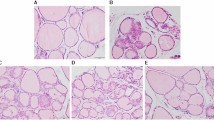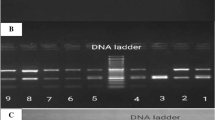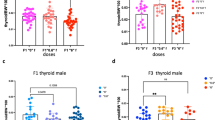Abstract
Aim:
To investigate the effects of diosgenin (Dio), a naturally occurring steroid saponin, on goiter formation in a mouse model of Graves' disease (GD) and the underlying mechanisms.
Methods:
Female BALB/c mice were injected with adenovirus expressing the A subunit of thyrotropin receptor to induce GD. The mice were treated with Dio (20, 100 mg·kg−1·d−1, ip) for 12 or 24 d. The serum levels of TT4 and TRAb were examined using radioimmunoassay and electrochemiluminescence. The size and morphology of thyroid glands were examined. Thyrocyte proliferation was determined using BrdU incorporation assay. The expression of proliferation-associated proteins IGF-1, NF-κB, cyclin D1, and PCNA in thyroids was analyzed using immunohistochemistry and real-time PCR.
Results:
The GD mice showed significantly high serum levels of TRAb and TT4 compared to the normal mice. Treatment of the GD mice with Dio for 24 d dose-dependently reduced the TT4 level and thyroid size, but did not affect the abnormal level of TRAb. Furthermore, Dio treatment dose-dependently reversed the morphological changes and reduced excessive thyrocyte proliferation in thyroids of the GD mice. Dio treatment also dose-dependently reduced the mRNA and protein levels of IGF-1, NF-κB, cyclin D1, and PCNA in thyroids of the GD mice.
Conclusion:
Dio relieves goiter in a mouse model of GD through the inhibition of thyrocyte proliferation. The mechanisms involve the suppression of IGF-1, NF-κB, cyclin D1, and PCNA expression.
Similar content being viewed by others
Log in or create a free account to read this content
Gain free access to this article, as well as selected content from this journal and more on nature.com
or
References
Prabhakar BS, Bahn RS, Smith TJ . Current perspective on the pathogenesis of Graves' disease and ophthalmopathy. Endocr Rev 2003; 24: 802–35.
Burch HB, Burman KD, Cooper DS . A 2011 survey of clinical practice patterns in the management of graves' disease. J Clin Endocrinol Metab 2012; 97: 4549–58.
Vitti P, Rago T, Chiovato L, Pallini S, Santini F, Fiore E, et al. Clinical features of patients with Graves' disease undergoing remission after antithyroid drug treatment. Thyroid 1997; 7: 369–75.
Cooper DS . Antithyroid drugs. N Engl J Med 2005; 352: 905–17.
He Z, Tian Y, Zhang X, Bing B, Zhang L, Wang H, et al. Anti–tumour and immunomodulating activities of diosgenin, a naturally occurring steroidal saponin. Nat Prod Res 2012; 26: 2243–6.
Raju J, Mehta R . Cancer Chemopreventive and Therapeutic Effects of Diosgenin, a Food Saponin. Nutr Cancer 2009; 61: 27–35.
Pari L, Monisha P, Mohamed Jalaludeen A . Beneficial role of diosgenin on oxidative stress in aorta of streptozotocin induced diabetic rats. Eur J Pharmacol 2012; 691: 143–50.
Kwon CS, Sohn HY, Kim SH, Kim JH, Son KH, Lee JS, et al. Anti-obesity effect of Dioscorea nipponica Makino with lipase-inhibitory activity in rodents. Biosci Biotechnol Biochem 2003; 67: 1451–6.
Uemura T, Goto T, Kang MS, Mizoguchi N, Hirai S, Lee JY, et al. Diosgenin, the main aglycon of fenugreek, inhibits LXRalpha activity in HepG2 cells and decreases plasma and hepatic triglycerides in obese diabetic mice. J Nutr 2011; 141: 17–23.
Moalic S, Liagre B, Corbiere C, Bianchi A, Dauca M, Bordji K, et al. A plant steroid, diosgenin, induces apoptosis, cell cycle arrest and COX activity in osteosarcoma cells. FEBS Lett 2001; 506: 225–30.
Liu MJ, Yue PY, Wang Z, Wong RN . Methyl protodioscin induces G2/M arrest and apoptosis in K562 cells with the hyperpolarization of mitochondria. Cancer Lett 2005; 224: 229–41.
Miyoshi N, Nagasawa T, Mabuchi R, Yasui Y, Wakabayashi K, Tanaka T, et al. Chemoprevention of azoxymethane/dextran sodium sulfate-induced mouse colon carcinogenesis by freeze-dried yam sanyaku and its constituent diosgenin. Cancer Prev Res (Phila) 2011; 4: 924–34.
Bian D, Li Z, Ma H, Mu S, Ma C, Cui B, et al. Effects of diosgenin on cell proliferation induced by IGF-1 in primary human thyrocytes. Arch Pharm Res 2011; 34: 997–1005.
Chen CR, Pichurin P, Nagayama Y, Latrofa F, Rapoport B, McLachlan SM . The thyrotropin receptor autoantigen in Graves disease is the culprit as well as the victim. J Clin Invest 2003; 111: 1897–904.
Rajkovic V, Matavulj M, Johansson O . Light and electron microscopic study of the thyroid gland in rats exposed to power-frequency electromagnetic fields. J Exp Biol 2006; 209: 3322–8.
Chen CY, Kimura H, Landek-Salgado MA, Hagedorn J, Kimura M, Suzuki K, et al. Regenerative potentials of the murine thyroid in experimental autoimmune thyroiditis: role of CD24. Endocrinology 2009; 150: 492–9.
Thoolen B . BrdUrd labeling of S-phase cells in testes and small intestine of mice, using microwave irradiation for immunogold-silver staining: an immunocytochemical study. J Histochem Cytochem 1990; 38: 267–73.
Livak KJ, Schmittgen TD . Analysis of relative gene expression data using real–time quantitative PCR and the 2(-Delta Delta C(T)) Method. Methods 2001; 25: 402–8.
Xavier LL, Viola GG, Ferraz AC, Da Cunha C, Deonizio JM, Netto CA, et al. A simple and fast densitometric method for the analysis of tyrosine hydroxylase immunoreactivity in the substantia nigra pars compacta and in the ventral tegmental area. Brain Res Brain Res Protoc 2005; 16: 58–64.
Pyo JS, Kang G, Kim DH, Chae SW, Park C, Kim K, et al. Activation of nuclear factor-kappaB contributes to growth and aggressiveness of papillary thyroid carcinoma. Pathol Res Pract 2013; 209: 228–32.
Itoi T, Shinohara Y, Takeda K, Nakamura K, Takei K, Sanada J, et al. Nuclear cyclin D1 overexpression is a critical event associated with cell proliferation and invasive growth in gallbladder carcinogenesis. J Gastroenterol 2000; 35: 142–9.
Iyengar B . Expression of proliferating cell nuclear antigen (PCNA): proliferative phase functions and malignant transformation of melanocytes. Melanoma Res 1994; 4: 293–5.
Nagayama Y, Saitoh O, McLachlan SM, Rapoport B, Kano H, Kumazawa Y . TSH receptor-adenovirus-induced Graves' hyperthyroidism is attenuated in both interferon-gamma and interleukin-4 knockout mice; implications for the Th1/Th2 paradigm. Clin Exp Immunol 2004; 138: 417–22.
Misharin A, Hewison M, Chen CR, Lagishetty V, Aliesky HA, Mizutori Y, et al. Vitamin D deficiency modulates Graves' hyperthyroidism induced in BALB/c mice by thyrotropin receptor immunization. Endocrinology 2009; 150: 1051–60.
Ueki I, Abiru N, Kobayashi M, Nakahara M, Ichikawa T, Eguchi K, et al. B cell-targeted therapy with anti-CD20 monoclonal antibody in a mouse model of Graves' hyperthyroidism. Clin Exp Immunol 2011; 163: 309–17.
Huang CH, Liu DZ, Jan TR . Diosgenin, a plant-derived sapogenin, enhances regulatory T-cell immunity in the intestine of mice with food allergy. J Nat Prod 2010; 73: 1033–7.
Huang CH, Ku CY, Jan TR . Diosgenin attenuates allergen–induced intestinal inflammation and IgE production in a murine model of food allergy. Planta Med 2009; 75: 1300–5.
Kirik OV, Beznin GV, Korzhevskii DE . Proliferation markers used in histological studies. Morfologiia 2009; 136: 95–100.
Volzke H, Friedrich N, Schipf S, Haring R, Ludemann J, Nauck M, et al. Association between serum insulin-like growth factor-I levels and thyroid disorders in a population-based study. J Clin Endocrinol Metab 2007; 92: 4039–45.
Maiorano E, Perlino E, Triggiani V, Nacchiero M, Giove E, Ciampolillo A . Insulin-like growth factor-1 and insulin-like growth factor receptor in thyroid tissues of patients with Graves' disease. Int J Mol Med 1998; 2: 483–6.
Ren M, Zhong X, Ma CY, Sun Y, Guan QB, Cui B, et al. Insulin-like growth factor-1 promotes cell cycle progression via upregulation of cyclin D1 expression through the phosphatidylinositol 3-kinase/nuclear factor-kappaB signaling pathway in FRTL thyroid cells. Acta Pharmacol Sin 2009; 30: 113–9.
Haddad JJ, Abdel-Karim NE . NF-kappaB cellular and molecular regulatory mechanisms and pathways: therapeutic pattern or pseudoregulation? Cell Immunol 2011; 271: 5–14.
Salminen A, Kaarniranta K . Insulin/IGF-1 paradox of aging: regulation via AKT/IKK/NF-kappaB signaling. Cell Signal 2010; 22: 573–7.
Kuo SH, Chou CH, Cheng AL, Wang CW, Chen YH, Chen RJ . Expression of BCL10 in cervical cancer has a role in the regulation of cell growth through the activation of NF-kappaB-dependent cyclin D1 signaling. Gynecol Oncol 2012; 126: 245–51.
Stacey DW . Cyclin D1 serves as a cell cycle regulatory switch in actively proliferating cells. Curr Opin Cell Biol 2003; 15: 158–63.
Travali S, Ku DH, Rizzo MG, Ottavio L, Baserga R, Calabretta B . Structure of the human gene for the proliferating cell nuclear antigen. J Biol Chem 1989; 264: 7466–72.
Li F, Fernandez PP, Rajendran P, Hui KM, Sethi G . Diosgenin, a steroidal saponin, inhibits STAT3 signaling pathway leading to suppression of proliferation and chemosensitization of human hepatocellular carcinoma cells. Cancer Lett 2010; 292: 197–207.
Srinivasan S, Koduru S, Kumar R, Venguswamy G, Kyprianou N, Damodaran C . Diosgenin targets Akt-mediated prosurvival signaling in human breast cancer cells. Int J Cancer 2009; 125: 961–7.
Acknowledgements
Dr Shu WANG (Ruijin Hospital of Shanghai Jiao Tong University, Shanghai, China) assisted with the delivery of the adenovirus. This work was supported through the National Natural Science Foundation of China (30901461, 81070625 and 81101590), the Natural Science Foundation of Shandong Province (2009CM005 and BS2010YY049) and the Ji-nan Self-renovation Plan for Colleges and Universities and Scientific Research Institutes (200906012) of China.
Author information
Authors and Affiliations
Corresponding authors
Rights and permissions
About this article
Cite this article
Cai, H., Wang, Z., Zhang, Hq. et al. Diosgenin relieves goiter via the inhibition of thyrocyte proliferation in a mouse model of Graves' disease. Acta Pharmacol Sin 35, 65–73 (2014). https://doi.org/10.1038/aps.2013.133
Received:
Accepted:
Published:
Issue date:
DOI: https://doi.org/10.1038/aps.2013.133
Keywords
This article is cited by
-
Transcriptome analysis of the effect of diosgenin on autoimmune thyroiditis in a rat model
Scientific Reports (2021)
-
Chronic diseases, inflammation, and spices: how are they linked?
Journal of Translational Medicine (2018)
-
STAT6 deficiency ameliorates Graves’ disease severity by suppressing thyroid epithelial cell hyperplasia
Cell Death & Disease (2016)



